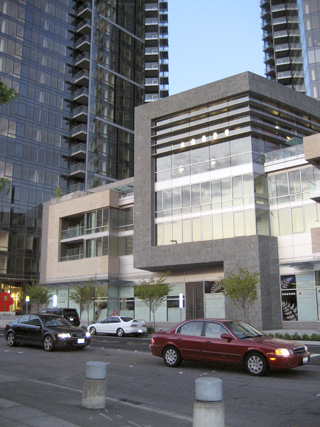|
Subscribe / Renew |
|
|
Contact Us |
|
| ► Subscribe to our Free Weekly Newsletter | |
| home | Welcome, sign in or click here to subscribe. | login |
Real Estate
| |
 |
September 10, 2009
Bellevue Towers builds on city’s urban identity
MulvannyG2 Architecture

Larson
|
Think of great American or European cities. Beautiful public spaces, marvelous, often iconic buildings and singular fountains and monuments capture our appreciation.
But look closer. Look at the streets themselves and the buildings that line them. They present the richness of the city — the shops, stoops, entrances to grand and humble places, and most important, they channel the activity of people moving from place to place, looking in windows, enjoying the life of the city.
Filled with present activity and future promise, streets activate our cities and display the tapestry of urban life. Overlooked during earlier decades of urban planning, today’s urban design thinking capitalizes on the street and its importance in creating good living in metropolitan communities.
Clear mission

Photo courtesy of June Hoffman Bellevue Towers’ twin high-rises, completed earlier this year, are 43 stories each and contain a total of 543 condo units. A six-story podium, shown here, includes retail and parking. |
The city of Bellevue, recognizing the value of the active street and easy pedestrian movement, started an initiative to reclaim their streets as a pedestrian precinct.
When Portland-based Gerding Edlen, the developer of Bellevue Towers, proposed a residential mixed-use project, the city gave a warm welcome. A practiced proponent of active streets in their work, Gerding Edlen understands what makes good urban design and good architecture. The designers for the project, a joint venture of GBD Architects of Portland and MulvannyG2 Architecture, began their design work with a clear mission.
Bellevue Towers, first of all, is two towers, paired twins resting on a single, six-story podium. The towers reach up 43 stories to a height of 450 feet. Together, they provide a total of 543 living units.
The twin towers provide a framework for dramatic urban living. However, the entire development — its massing, how it meets the ground, how it relates to the street, how it responds to the surrounding context — plays an equal role in delivering a memorable urban experience.
Design intentions
The team focused on three primary urban design intentions for the project. First, create a building unique in the skyline — that first view that compels us to explore and want to see more.
Bellevue Towers makes an unforgettable statement on the emerging Bellevue skyline, but they really succeed when seen within closer confines.
The designers shaped the surfaces of the towers to provide decks that are both projected from and inset into the tower surface. On the curved outer facades, the deck patterns, organized vertically into groupings of six floors, produce a rhythm that can be seen and appreciated from the street.
Patterns of opaque and transparent glass also follow the six-floor grouping as do a series of metal trim strips. Taken together, these design moves give the tower a subtle texture and elegant presence when seen from any vantage point.
Second, the designers wanted a building that when seen from across the street or down the block offered contextual variety in its form, size, color and texture.
The building podium contains a 900-car parking structure. While much of the parking lies underground, six levels do rise above ground level.
To disguise the parking and break the podium into smaller elements, the designers placed living units on the street sides of each podium floor, concealing parking immediately behind, but not disruptive to the residents. The amenity spaces for the residences are also located in the podium along the west face. Retail spaces front the street at ground level.
Making these choices permits organizing street facades into architecturally distinct elements with windows and decks overlooking the street. Additionally, the designers modulated the street facades by incorporating two colors of granite as surfacing material punctuated by metal panels, grilles and glass balcony rails.
These key design moves connect the towers to the podium in a harmonious relationship emphasizing form, scale, material, color and texture while settling the large structure into its street context.
Third, the team determined to bring to the street itself an instantly recognizable urban experience dynamically expressive of a changing and maturing city.
Until recently, development in the city of Bellevue provided generous setbacks, large and small plazas and ample landscaped gardens, but also numerous small buildings and surface parking lots in an environment of wide streets, fast traffic and large blocks. Most would agree this did not represent a recognizable urban environment.
At Bellevue Towers all the building facades are pressed tightly to the back of sidewalk. The street environment becomes narrower than has usually been found in Bellevue, but it is this characteristic that both creates and recalls our associations to enjoyable city experiences. New York, Chicago, even San Francisco display the life of the city in constrained but dynamic street environments teeming with excitement.
The strategy works, however, only when street-level shops and businesses generate and maintain pedestrian activity and when that activity is distributed along the entire street frontage of the building.
At Bellevue Towers the tower lobbies provide small plaza setbacks from the sidewalk. These spaces contain large art pieces, benches and large, open windows that reveal a generous art collection displayed within the comfortable lobbies themselves. Soon, the restaurant group Purple expects to open three new venues in the building’s retail space. This is when Bellevue Towers’ street life will truly come alive.
As new projects go up, the active street becomes more and more a reality. An urban character is emerging in the city of Bellevue punctuated by tall residential towers and interesting and vital streets. The Bellevue Towers development is helping lead the way to the city’s dream of a vital, walkable city.
Gary Larson, AIA, is a senior principal at MulvannyG2 Architecture. With over 47 years of experience, he leads the firm’s commercial group, dedicated to designing mixed-use high-rise and corporate projects worldwide.
Other Stories:
- Downtown Bellevue looks to cement its successes
- Bellevue’s office outlook rosier than Seattle’s
- 10.5-acre site a chance to define downtown Bellevue
- Bravern developers mastermind a high-flying project
- A closer look at The Bravern
- Bravern aims to create a sense of place
- Virtual design helps light up Neiman Marcus
- Bellevue can help developers by giving lenders less to fret about


